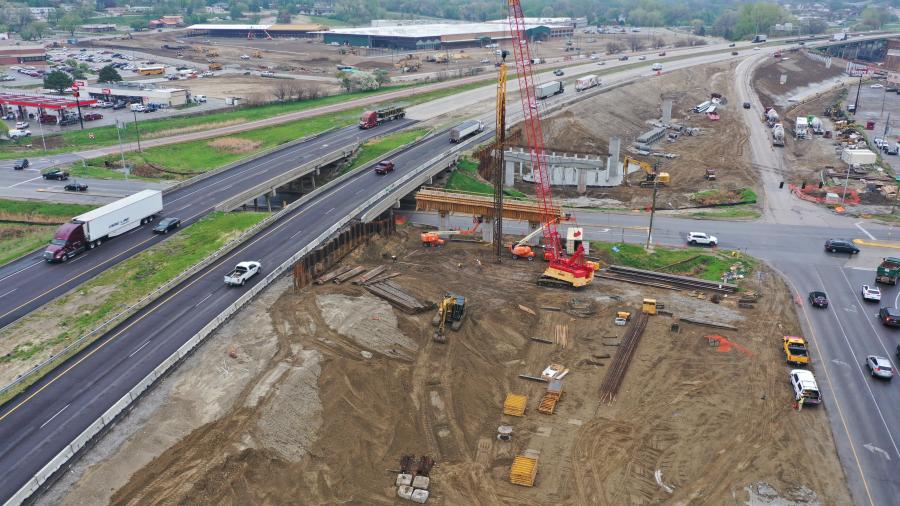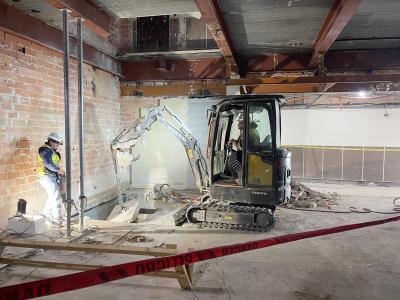Photo courtesy of Iowa DOT
The $114 million Madison Avenue Interchange reconstruction project will expand the interstate capacity to the east of the I-80/I-29 East System interchange and replace deteriorating bridges.
As the final piece in the comprehensive Council Bluffs Interstate System Improvement Program puzzle, the $114 million Madison Avenue Interchange reconstruction project will expand the interstate capacity to the east of the I-80/I-29 East System interchange and replace deteriorating bridges. Other than routine maintenance, the original interchange has not been significantly updated since it was built in the 1960s.
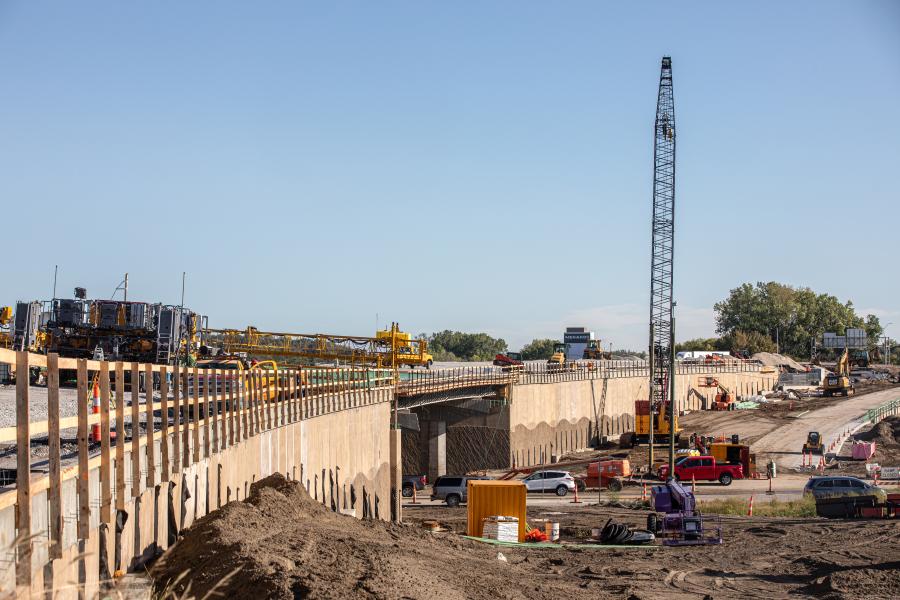
Photo courtesy of Iowa DOT
"Overseeing a multi-year project like the Council Bluffs Interstate Improvement Program is a complex task that requires meticulous planning and organization," said Scott Schram, Iowa Department of Transportation (DOT) District 4 engineer. "The project team didn't just tackle issues one at a time to achieve the needed improvements. That would have increased the duration of construction, as well as the overall costs. Instead, a program management approach was adopted for the project. It wasn't just addressing one deficiency; it was a corridor approach."
The planned upgrades include adding a travel lane and a bike/pedestrian path on Madison Avenue. The project also will streamline traffic flow by enabling vehicles to merge onto the I-80 westbound ramp directly from Madison Avenue without the need for a full stop.
"With multiple moving parts, the team focused on timing design efforts to match construction schedules," Schram said. "We maintained the program schedule by anticipating approvals and monitoring construction progress. But the key to our success is strong relationships with all partners, including major contractors and prime consultants.
"Regular construction partnership meetings were held to work through higher-level issues that could impact the program. These partnerships were essential to transition through the early years of reconstruction and getting everything moving as efficiently as possible."
With a high volume of daily traffic on the interstate, Iowa DOT was concerned about traffic impacts during construction. The project team developed innovative staging and maintenance of traffic plans, and detours were developed to assist drivers to travel to their destinations in the most efficient way.
The I-80 eastbound ramp from Madison Avenue was closed for six months in 2023 for reconstruction. This year, motorists may encounter short-term/overnight closures of the westbound ramps and interstate for construction or some traffic shifts, but no long-term closures are expected.
Schram said coordination remains critical to the success of the project. Construction is occurring next to residential areas, so noise, vibration and dust are a challenge for contractors and residents.
Schram said, "Hawkins Construction Company brings a wealth of expertise to the table, having actively participated in numerous stages of the Council Bluffs Interstate Improvement Program. Their established rapport with the Iowa DOT is a testament to their ability to navigate the intricacies of needed procedures, ensuring efficient communication and prompt progression of change approvals.
"With a meticulous approach to plan review, Hawkins consistently identifies strategic opportunities for value engineering, not only enhancing the overall quality of the project, but also delivering cost-saving benefits for taxpayers. Their involvement in the adjacent contract equips them with a nuanced understanding of the area's specific requirements. This insight allows for a seamless transition and continuity in the project's execution, further underscoring their suitability for this undertaking."
Currently, the eastbound contract is ahead of schedule, with only some median grading and paving to be completed in its final stage and will be complete by late spring. The westbound contract kicked off early this year, based on good weather. Contractors have already completed the early clearing and grubbing, along with fence removal, and have begun ramp grading and storm sewer work.
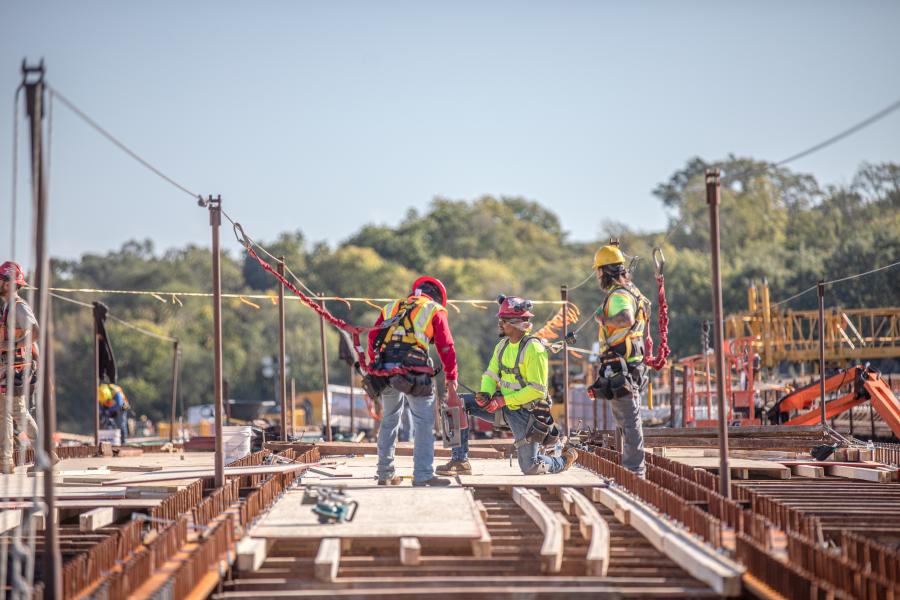
Photo courtesy of Iowa DOT
According to Mark Pohlmann, HDR, PM/GEC project manager, the Madison Avenue Interchange undertaking has faced numerous obstacles.
"They include the high-water table in the area and other geotechnical issues to address stabilizing the existing soil upon which the new bridges and pavement are being built. The project site has experienced localized flooding due to spikes in Mosquito Creek water levels caused by winter and spring rain events, which complicated the construction process. Despite these challenges, the team has collaborated effectively with the contractor to develop appropriate mitigation strategies that will be used throughout the duration of construction."
Pohlmann said constructing a bridge over a navigable waterway poses inherent challenges, but building one that spans a creek, railroad track and a city street is particularly difficult.
"Stakeholder management is crucial, addressing diverse interests from each. Working through the permitting and plan approval process is just the beginning. Multiple work plans need to be submitted for review and approval months in advance to minimize delays. Interstate roadways and ramps, along with city roadways, need to remain open to the public, so staging and protection of the workers, heavy equipment and materials is always changing.
"Utility relocations that were impractical before construction began need to be identified and mitigated quickly. Long lead times for material deliveries also exacerbate the continual evaluation and adjustment to the project schedules, so constant communication is essential for success."
So far, the biggest, unexpected issues have been working with the high-water table, occasional localized flooding and other geotechnical issues with existing soil. A proactive approach to anticipate potential issues and plan for them has been extremely valuable.
The plans call for a reconstructed interchange, which will be a tight urban diamond.
"Shifting the interstate footprint and tightening interchange ramps improves sightlines and acceleration but creates a hazardous worksite with multiple jobsite access points. An Intelligent Work Zone system mitigates risk by detecting and notifying drivers when work trucks are merging onto the interstate lanes, improving safety for all.
There are a total of six bridges involved in the last leg of the program, the Madison Avenue project. The eastbound bridges have been completed and are open to interstate traffic. Work on the westbound bridges will begin in spring 2024 and is scheduled to be complete in the summer of 2025.
Part of the construction effort involves building longer acceleration lanes.
"The new ramp design will significantly enhance safety at one of the most dangerous locations for vehicles on the interstate, at the merge point. This improvement gives merging vehicles ample space to reach interstate speeds before merging in, while also increasing their visibility to interstate traffic. To accommodate the extended ramps, separate bridges were built over the nearby railroad tracks."
Pohlmann said construction of the westbound phase is beginning this year. The contractor has completed some initial clearing and grubbing, fence removal and will begin bridge demolition of the old (closed) eastbound bridges in March. Early-stage ramp grading and storm sewer work has also begun near Madison Avenue.
Heavy equipment being used includes Manitowoc and Terex cranes; Cat excavators; Cat 330 or greater loaders; Cat 980 wheel loaders; Cat dozers — D8 or greater; Cat motor graders; Cat 140 or greater mini-excavators; skid loaders; dump trucks; vibratory roller; concrete pavers; portable concrete batch plants; portable concrete crusher plants; subgrade trimmers with concrete hopper attachments; JLG boom lifts; JLG forklifts; and power brooms.
Portland cement concrete, structural steel girders, concrete girders and class 10 (sand and clay) embankment are among the materials being used, as well as lightweight foam concrete fill, EPS Geofoam blocks and full-height tilt-up wall panels at numerous retaining wall locations.
Pohlmann said the current focus on grading and storm sewer installation, which are highly susceptible to frozen ground conditions, presents a valuable opportunity to make substantial headway on the overall work schedule during Iowa's milder January and February months this year. Construction of the four-span steel girder bridge over the railroad track, Mosquito Creek and a city street is poised to begin soon. By initiating this critical phase early, crews stand to significantly shorten the project's overall timeline.
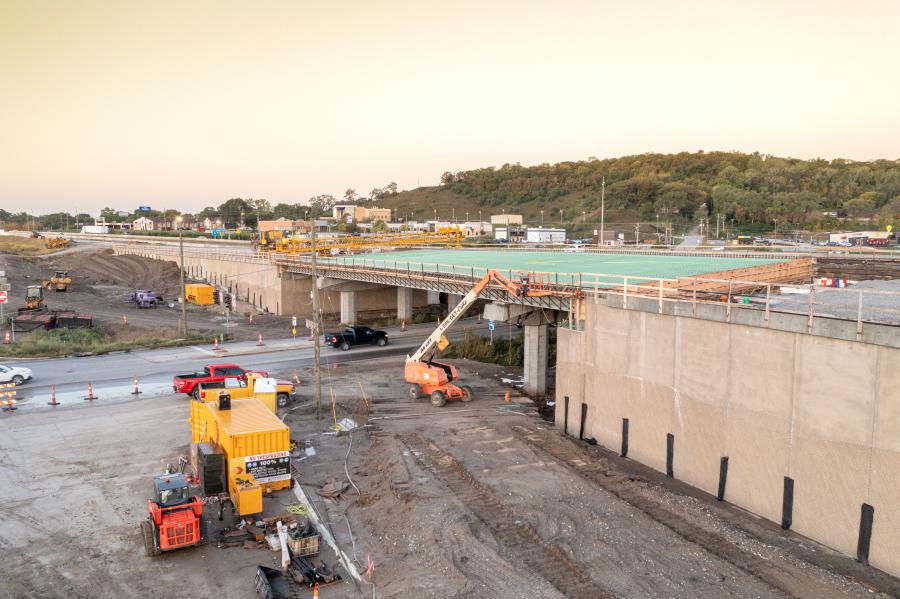
Photo courtesy of Iowa DOT
"As the Council Bluffs Interstate System Improvement Program nears the end of construction, it is important to reflect on the significant investment that the Iowa Transportation Commission has made in our area's state transportation infrastructure," Pohlmann remarked. "This investment has had a profound impact on our community, both in terms of the physical improvements made to the interstate system and the resulting economic and social benefits."
Schram added that working on the project is rewarding on many different levels.
"The new widened lanes and shoulders, new bridges and interchanges, improved drainage and lighting and aesthetic enhancements have all made our interstate system safer, more efficient and visually appealing. These improvements will make it easier for residents and visitors to travel through our community, and they will also help to attract new businesses and residents.
"It brings progress. Community infrastructure is a sign of progress. And I think we've done that with this program." CEG
Cindy Riley
Birmingham, Ala., native Cindy RIley originally planned on a career in law, but during her sophomore year in college realized journalism was her true calling. A magna cum laude graduate of Samford University, Riley first worked in radio and TV. Named Best News Anchor, Best News Reporter and Best Investigative Reporter by the Associated Press, she interviewed numerous personalities, ranging from Dr. Henry Kissinger and President Bush to Michael Jordan and Captain Kangaroo.
As a print journalist, Riley has covered a variety of topics, including construction, business, health and the arts. In addition to CEG, her work has appeared in special reports for USA Today and the L.A. Times. Other publications have included New South Magazine, Portico, Thicket, Alabama Heritage, B-Metro, Business First and Birmingham Business Journal.
Read more from Cindy Riley here.
Today's top stories



